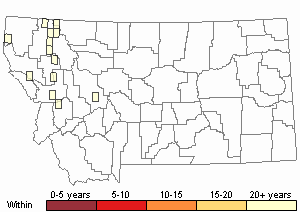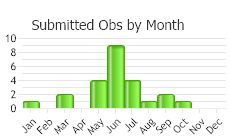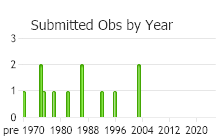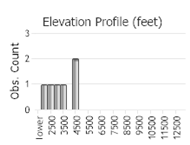View in other NatureServe Network Field Guides
NatureServe
Montana
Utah
Wyoming
Idaho
Wisconsin
British Columbia
South Carolina
Yukon
California
New York
A Plagiomnium Moss - Plagiomnium venustum
General Description
Plants: Acrocarpous (Vitt 1988), sometimes growing in extensive patches of upright shoots or in mats (FNA 2014), sometimes interspersed with other moss species (Lawton 1971), green or green with yellow tones (FNA 2014). Fertile stems upright, green or somewhat brown, with brown tomentum proximally (Lawton 1971), 20-60 mm tall; infertile stems lacking (FNA 2014).
Leaves: Smaller and more distant below, wavy, somewhat bent, curved or, especially above, twisted when dry, plane (FNA 2014) and spreading when damp (Lawton 1971), 3-7 mm in length (FNA 2014), 2-3 mm in width (Lawton 1971), widest in the middle to obovate, narrowing to an acumen or acute leaf tip, or tip seldom more widely-angled to curved, or with a dentate cusp; base sometimes extending downward along the stem; margins flat, sharply dentate from the apex to a little below mid-leaf or further, sometimes reaching the bottom; costa reaching or exceeding the leaf tip, seldom ending just shy of it (FNA 2014).
Leaf Cells: Marginal teeth 1- to 3-celled; cells at the leaf edge arranged in 1 layer, long and thin, in 3-5 series; medial laminal cells with length about the same as or a little longer than the width, the cells smaller near the margins, occurring in up-and-down rows, seldom obliquely-rowed, nonporose (FNA 2014), both walls and wall angles thick (Lawton 1971).
Phenology
Fruit ripens in the last part of spring into the first part of summer (FNA 2014).
Diagnostic Characteristics
This is the only Plagiomnium that does not have infertile stems. The deeply colored guard cells of the stomata are also characteristic (FNA 2014).
Range Comments
North American Range
AK, BC s to CA, also ID and MT (FNA 2014). Known in Montana from Flathead, Granite, Lake, Lewis and Clark, Lincoln, and Missoula Counties (Elliott and Pipp 2016).
Observations in Montana Natural Heritage Program Database
Number of Observations: 27
(Click on the following maps and charts to see full sized version)
Map Help and Descriptions
Relative Density

Recency



 (Observations spanning multiple months or years are excluded from time charts)
(Observations spanning multiple months or years are excluded from time charts)
Habitat
Moist soil (Vitt 1988), organic soil, stone, decaying wood, at the bottom of trees, forests (FNA 2014). Occurring from low elevations to about 3940 feet (Lawton 1971). )
Reproductive Characteristics
Archegonia and antheridia associating in the same bract cluster. Fruiting common. Seta 1-6 per perichaetium, 30-40 mm tall (FNA 2014), russet proximally, yellow distally (Lawton 1971). Capsule 3-4.5 mm in length, drooping to level, frequently creased (FNA 2014), yellow with a deep brown neck (Lawton 1971), the neck easily apparent (FNA 2014); stomata sunken with guard cells partially hidden (Lawton 1971), the guard cells mammillose and deeply colored (FNA 2014); exostome teeth papillose; endostome processes widely perforate on the strong, longitudinal fold; cilia somewhat knobby (Lawton 1971).
Stewardship Responsibility
References
- Literature Cited AboveLegend:
 View Online Publication
View Online Publication Elliott, J.C. and A.K. Pipp. 2018. A Checklist of Montana Mosses (1880-2018). Updated 3 January, 2020. Montana Natural Heritage Program, Helena, Montana. 73 pp.
Elliott, J.C. and A.K. Pipp. 2018. A Checklist of Montana Mosses (1880-2018). Updated 3 January, 2020. Montana Natural Heritage Program, Helena, Montana. 73 pp. Flora of North America Editorial Committee, eds. 2014. Flora of North America North of Mexico. Volume 28. Bryophytes: Mosses, Part 2. Oxford University Press, Inc., NY. xxi + 702 pp.
Flora of North America Editorial Committee, eds. 2014. Flora of North America North of Mexico. Volume 28. Bryophytes: Mosses, Part 2. Oxford University Press, Inc., NY. xxi + 702 pp. Lawton, E. 1971. Moss Flora of the Pacific Northwest. Hattori Botanical Laboratory. Japan: Yamabuki-cho, Shinjuku-ku, Tokyo. 362 pages plus appendices.
Lawton, E. 1971. Moss Flora of the Pacific Northwest. Hattori Botanical Laboratory. Japan: Yamabuki-cho, Shinjuku-ku, Tokyo. 362 pages plus appendices. Vitt, D. J. Marsh, and R. Bovey. 1988. Mosses, Lichens & Ferns of Northwest North America. Seattle, WA: University of Washington Press. 296 p.
Vitt, D. J. Marsh, and R. Bovey. 1988. Mosses, Lichens & Ferns of Northwest North America. Seattle, WA: University of Washington Press. 296 p.
- Additional ReferencesLegend:
 View Online Publication
View Online Publication
Do you know of a citation we're missing? Elliot, J. C. 1993. Second checklist of Montana mosses. Unpublished report. U.S. Forest Service, Region 1. Missoula, MT. 45 pp.
Elliot, J. C. 1993. Second checklist of Montana mosses. Unpublished report. U.S. Forest Service, Region 1. Missoula, MT. 45 pp. Lawton, E. 1971. Keys for the Identification of the Mosses on the Pacific Northwest. Reprinted from 'Moss Flora of the Pacific Northwest'. Published as Supplement No. 2 of the Journal of the Hattori Botanical Laboratory. Nichinan, Miyazaki, Japan. 66 pp.
Lawton, E. 1971. Keys for the Identification of the Mosses on the Pacific Northwest. Reprinted from 'Moss Flora of the Pacific Northwest'. Published as Supplement No. 2 of the Journal of the Hattori Botanical Laboratory. Nichinan, Miyazaki, Japan. 66 pp. Malcolm, B., N. Malcolm, J. Shevock, and D. Norris. 2009. California Mosses. Nelson, New Zealand: Micro-Optics Press. 430 pp.
Malcolm, B., N. Malcolm, J. Shevock, and D. Norris. 2009. California Mosses. Nelson, New Zealand: Micro-Optics Press. 430 pp.
- Web Search Engines for Articles on "A Plagiomnium Moss"





